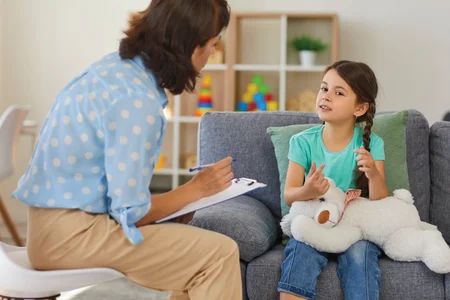4 min read
Last updated 10/4/22
Therapeutic Goals & Interventions for Children with ADHD

Melissa Leeth, M.A.

Since my son Nicky was in preschool, he’s always been on the go, go, go. At the time, I was reassured that his behaviors were appropriate for his age.
Presently, Nicky is a 9 year old and in the 4th grade. Since the beginning of the school year, his teacher has shared greatly enjoying Nicky’s outgoing personality, but has concerns for his fidgety, talkative, and often disruptive behaviors.
The structured school environment is especially challenging for Nicky in many ways: sitting behind a desk, following directions, standing in a line, and transitioning from recess back to the classroom. I knew as a parent that it was time to seek professional help when Nicky darted out from behind a school bus on a recent field trip.
Given all these concerns, Nicky and I met with a psychologist for an initial evaluation. The psychologist recommended that Nicky’s teacher and I complete an assessment to rate the frequency of ADHD symptoms we have observed for Nicky in the past 6 months.
With this additional information, the psychologist determined that Nicky met the diagnostic criteria for ADHD, combined presentation. This means that Nicky struggles with both inattention (lack of focus) and hyperactivity (increased bodily movement).
For ongoing care, the psychologist recommended that we work with a licensed social worker named Carrie. Carrie has much experience working with children with ADHD and is trained in cognitive behavioral therapy (CBT), which is an evidence based treatment approach for ADHD.
Carrie shared it is best to focus on behavior change in the two environments Nicky spends the majority of his time in: school and home. Here are some of the therapeutic goals and interventions Carrie recommended for Nicky…
Therapeutic Goals & Interventions for Children with ADHD
Adapted from The Child Psychotherapy Treatment Planner, Fifth Edition, the following are therapeutic goals and interventions that can be used for children with ADHD:Goal: Increase on task behaviors
Interventions:
1. Use an organizational system (calendars, charts, notebooks, or other ways of recording) to track a child’s completion of school assignments and household chores and responsibilities.
- For Nicky, to increase on task behaviors, we use a “pom pom” jar. For every positive behavior choice he makes at school or home, he gets a pom pom in the jar. His teacher adds pom poms to a baggie that goes home with him every night. Once the pom pom jar is filled to the top, Nicky earns a reward, which he has decided is choosing the weekly family movie, activity, or restaurant.
- We’ve modified this approach as needed to adapt to Nicky’s needs. At first, we started with a smaller jar to work towards earning a few, smaller rewards and over time have increased to a larger jar to work towards earning greater rewards. Carrie shared that delaying instant gratification is especially challenging for children with ADHD, so we’ve used this approach to encourage Nicky to work towards achieving long term goals.
2. Develop a routine schedule for child to increase their compliance with school, household, or work related responsibilities.
- Carrie suggested creating a visual day chart for Nicky to follow.
- Nicky moves his magnet piece to each part of the day so he knows what activities (brushing his teeth, making his bed, doing homework, etc.) he should be doing. We are able to adjust this schedule to meet our family’s daily needs.
Goal: Modify parenting strategies as necessary and increase support for parents
Interventions:
1. Parents learn and implement Parent Management Training approach by:
- Prompting and reinforcing positive behaviors
- Using clear instruction, time out, and other loss of privilege practices for problematic behavior
- Through Parent Management Training, I learned various parenting strategies and skills to use with Nicky to support him in making positive behavior choices.
2. Encourage parents to regularly attend and actively participate in ADHD support groups
- I enjoy attending an ADHD parent support group. I have learned lots of tips and strategies to use. It was helpful to hear both the struggles and victories other parents have experienced… The best part for me was knowing I wasn’t alone in this journey.
Goal: Learn and apply strategies to better manage ADHD symptoms
Intervention:
1. “Stop, look, listen, and think” approach
- Nicky created a paper stoplight to use at home and school. We used construction paper to create red “Stop”, yellow “Think,” and green “Go” circles. Nicky added drawings of behaviors he thought went into each of these categories.
Additional resources: Whole body (holistic) listening and self control skills1. The character “Listening Larry” can be a great way to explain whole body (holistic) listening skills to kids.
- The Whole Body Listening Larry resources taught Nicky that it is important to listen with all his body parts: ears, brain, eyes, mouth, hands, feet, body position (facing the speaker), and with his heart (to show caring).
2. Hunter & His Amazing Remote Control can be a useful book and guide to use with kids struggling with ADHD.
- Nicky created his own paper self control remote control.
- Nicky presses the pause and fast forward buttons to consider all the consequences of his behavior choices.
- To reflect on past behavior choices, Nicky presses rewind.
- Nicky turns his volume buttons up or down to align with the setting of his environment.
- Nicky makes sure to “stay on the same channel” or topic his teacher and parents are discussing.
These therapeutic interventions have been very helpful in better managing Nicky’s ADHD symptoms. Since adding these, he has had less behavioral incidents at school. I have noticed too that Nicky seems more confident in his own abilities to manage his body and words. With my permission in place, his teacher has been able to collaborate with Carrie to create specific classroom interventions such as a calming corner for him to visit when he’s overstimulated and seat modifications to allow his busy body to keep moving throughout the day.
My message to other parents of children with ADHD: you aren’t alone and help is available. When advocating for your child, It’s best to consult with your child’s pediatrician, a mental health provider, and school staff to see what options are available to support your child in better managing their ADHD symptoms.
Resources
For more information and resources about ADHD, check out our educational articles here: ADHD Hub
References
Copeland, L. A. (2019). Hunter and His Amazing Remote Control. YouthLight, Incorporated. https://www.youthlight.com/product.php?id=12
Jongsma, A. E., Peterson, L. M., McInnis, W. P., & Bruce, T. J. (2014). The Child Psychotherapy Treatment Planner (5th ed.). John Wiley & Sons. https://www.wiley.com/en-ca/The+Child+Psychotherapy+Treatment+Planner%3A+Includes+DSM+5+Updates%2C+5th+Edition-p-9781118418888
NICHQ Vanderbilt Assessment Scales. Retrieved from https://www.nichq.org/sites/default/files/resource-file/NICHQ-Vanderbilt-Assessment-Scales.pdf on September 28, 2022.
Sautter, E., & Wilson, K. (2016). Whole Body Listening Larry at School! SocialThinking.com. https://www.socialthinking.com/whole-body-listening
